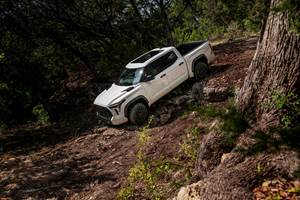Petrobras Pioneers Topside Composites
Petrobras (Rio de Janeiro, Brazil) was the first major oil company to experiment with molded gratings in the 1980s, though these early products proved unsatisfactory due to wide variations in mechanical properties. However, advances in pultrusion and filament winding technology coupled with the availability of
Petrobras (Rio de Janeiro, Brazil) was the first major oil company to experiment with molded gratings in the 1980s, though these early products proved unsatisfactory due to wide variations in mechanical properties. However, advances in pultrusion and filament winding technology coupled with the availability of low-cost epoxy and vinyl ester resins enabled the company to begin large-scale introduction of composites just one year after offshore and maritime application standards were issued in 1993. Petrobras started with gratings produced by Brazilian manufacturer Cogumelo (Rio de Janeiro, Brazil), a supplier of a broad range of pultruded products for the industrial market. Information was gathered for two years before Petrobras issued a technical specification for its topside access products and for tanks and pipes. Initially, the company tested composite products on old platforms where the installation design did not have to be changed.
Guilherma Pessoa, material engineer for the Cenpes/Petrobras Research & Development Centre, explains that this practice allowed the company to validate the fire-retardant, low-smoke-emission and mechanical-resistance properties of the new materials over time, and to fit their use into its procedures and safety philosophy.
Initially, Petrobras viewed composite materials as a way to reduce weight in floating units. However, when it became clear how well these products weathered the difficult Campos Basin conditions, the focus of the program evolved into reducing maintenance costs. Corroded steel gratings, cable trays, chemical tanks, pipes and railings are often replaced with composite versions during maintenance procedures. According to Pessoa, about 40 percent of replacement gratings are composite Petrobras has discovered that composite materials save them about 40 percent in maintenance costs, surpassing carbon steel for cost-effectiveness.
Petrobras now installs composite components on all its new projects. For example, all of its platforms constructed since 1994 use nonmetallic gratings. In 1996, Project P-19 used composite cable trays in its plant because the exposed deck area was vulnerable to salt spray. The cable trays remain in good condition today. In contrast, P-27’s stainless steel cable trays, installed at the same time, were corroded by salt spray in just two years. On the P-37 offshore platform, 65 percent of the topside components are made of composite materials — the largest percentage to date.
Fibergrate Composite Structures Inc. (Addison, Texas, U.S.A.) has produced molded grating since 1966. The company’s USCG-approved phenolic products are installed on numerous fixed platforms in the Gulf of Mexico, says Ken Berg, director of corporate engineering. Recently, the company was selected to provide over 120,000 ft²/11,148m² of phenolic grating for Shell’s Na Kika platform, currently under construction in Korea.
The Composites Division of Lionweld Kennedy Ltd. (Middlesborough, U.K.) provides phenolic gratings, handrails and ladders to offshore platforms and FPSOs. The company’s pultruded FRP products are capable of meeting the fire-retardance standard BS 476 Part 6 and 7, Class 0. While composite products have proven durable, the most common complaint is that the non-slip surface wears out, requiring hand application of a new coat of quartz grit and resin to restore the nonskid surface. If FRP splinters, it is possible for corrosive chemicals to penetrate the system. If chips or cracks are not promptly treated, the composite panel can experience fiber bloom, which can split the panel and make panel replacement necessary.
Creative Pultrusions Inc. (Alum Bank, Pa., U.S.A.) is another supplier of offshore gratings and floor panels. The company’s trademarked Supergrate molded and pultruded gratings and pultruded handrails and ladders are in service on the Troll gas compression plant on Norway’s west coast. Over 9 miles/15 km of handrail were installed at that facility.
Related Content
Industrial equipment manufacturer expands global footprint, reaches into new markets
India-based CW Top Shops honoree EPP Composites reflects on a recently successful vertical filament winding application and new pultruded FRP rebar capabilities, as well as future opportunities.
Read MoreSeat frame demonstrates next-generation autocomposites design
Light weight, simplified/cost-effective manufacturing, passenger comfort and safety informed materials and process innovations and won awards for the 2022 Toyota Tundra‘s second-row seat frame.
Read MoreBiocomposite for mobile architecture, low load-bearing applications
The German Institutes of Textile and Fiber Research and partners have developed a biocomposite well suited for support profiles and connecting nodes in construction applications.
Read MoreNovel processes for hybrid thermoset-thermoplastic pultruded parts
CFRP pultrusion and pullwinding specialist Epsilon Composite combines thermoplastic overmolding with traditional thermoset processes, demonstrated through aircraft struts and industrial applications.
Read MoreRead Next
Other Applications Expand
A growing area in the offshore world is the refitting or “recycling” of older oil platforms to support additional production. A particularly active area for recycling is in the North Sea, where additional pipelines can be run to existing rigs for about $1 million (as opposed to spending $20 million for a new r
Read MoreCW’s 2024 Top Shops survey offers new approach to benchmarking
Respondents that complete the survey by April 30, 2024, have the chance to be recognized as an honoree.
Read More























